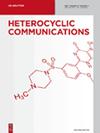Isatin as a simple, highly selective and sensitive colorimetric sensor for fluoride anion
IF 1.5
3区 化学
Q3 CHEMISTRY, ORGANIC
引用次数: 12
Abstract
Abstract Herein, we report the fluoride anion sensing properties of a commercially available and inexpensive organic compound, isatin, which is found to be a highly selective and sensitive sensor. In naked-eye experiments, by addition of fluoride anions, isatin shows a dramatic color change from pale yellow to violet at room temperature, while the addition of other anions, i.e. C l − , $\mathrm{Cl}^-,$ B r − , I − , C l O 4 − , H 2 P O 4 − a n d P F 6 − , $\mathrm{Br}^-,\mathrm I^-,\mathrm{ClO}_4^-,{\mathrm H}_2\mathrm{PO}_4^-\,\mathrm{and}\,\mathrm{PF}_6^-,$did not induce any colour change. Additionally, recognition and titration studies have also been done through UV/Vis spectroscopy. Isatin displayed a new absorption band at 533 nm after the addition of fluoride anions, which is presumably due to acid-base interaction between isatin and fluoride anions, while other anions did not trigger noticeable spectral changes. The detection limit was observed to be 0.367 ppm. DFT calculations were also performed to further explain the behavior of receptor 1 towards the Fˉ anion. Owing to high sensitivity and selectivity, isatin can be useful in the detection of biologically or environmentally important fluoride anions at very low concentration.Isatin作为一种简单、高选择性、灵敏的氟离子比色传感器
摘要本文报道了一种市售且价格低廉的有机化合物isatin的氟离子敏感特性,该化合物被发现是一种高选择性和敏感的传感器。在肉眼的实验中,通过添加氟阴离子,靛红显示了显著的颜色变化,从淡黄色到紫色在室温下,而其他阴离子,即C l−美元\ mathrm {Cl} ^ - $ B r−−,C l O 4−H 2 P O 4 n d P F 6−−,美元\ mathrm {Br} ^ - \ mathrm我^ - \ mathrm {ClO} _4 ^ - {\ mathrm H} _2 \ mathrm{阿宝}_4 ^ - \ \ mathrm{和}\ \ mathrm {PF} _6 ^,美元没有引起任何颜色改变。此外,还通过紫外/可见光谱进行了识别和滴定研究。氟离子加入后,Isatin在533 nm处出现了新的吸收带,这可能是由于Isatin与氟离子的酸碱相互作用,而其他阴离子没有引起明显的光谱变化。检出限为0.367 ppm。DFT计算也进一步解释了受体1对F -离子的行为。由于具有高灵敏度和选择性,isatin可用于检测极低浓度的生物或环境重要氟化物阴离子。
本文章由计算机程序翻译,如有差异,请以英文原文为准。
求助全文
约1分钟内获得全文
求助全文
来源期刊

Heterocyclic Communications
化学-有机化学
CiteScore
3.80
自引率
4.30%
发文量
13
审稿时长
1.4 months
期刊介绍:
Heterocyclic Communications (HC) is a bimonthly, peer-reviewed journal publishing preliminary communications, research articles, and reviews on significant developments in all phases of heterocyclic chemistry, including general synthesis, natural products, computational analysis, considerable biological activity and inorganic ring systems. Clear presentation of experimental and computational data is strongly emphasized. Heterocyclic chemistry is a rapidly growing field. By some estimates original research papers in heterocyclic chemistry have increased to more than 60% of the current organic chemistry literature published. This explosive growth is even greater when considering heterocyclic research published in materials science, physical, biophysical, analytical, bioorganic, pharmaceutical, medicinal and natural products journals. There is a need, therefore, for a journal dedicated explicitly to heterocyclic chemistry and the properties of heterocyclic compounds.
 求助内容:
求助内容: 应助结果提醒方式:
应助结果提醒方式:


